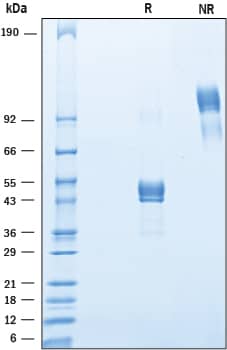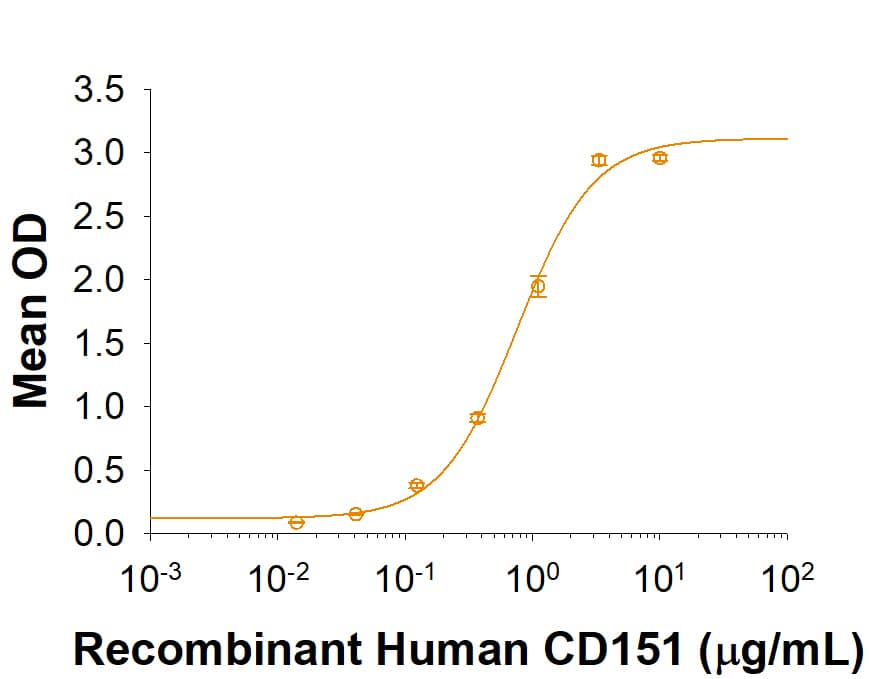Recombinant Human CD151 Fc Chimera Protein, CF
R&D Systems, part of Bio-Techne | Catalog # 1884-CD

Key Product Details
Source
CHO
Accession #
Structure / Form
Disulfide-linked homodimer
Conjugate
Unconjugated
Applications
Bioactivity
Product Specifications
Source
Chinese Hamster Ovary cell line, CHO-derived human CD151 protein
| MD | Human IgG1 (Pro100-Lys330) |
IEGR | Human CD151-LEL (Ala113-Arg221) Accession # P48509 |
| N-terminus | C-terminus | ||
Purity
>95%, by SDS-PAGE visualized with Silver Staining and quantitative densitometry by Coomassie® Blue Staining.
Endotoxin Level
<0.10 EU per 1 μg of the protein by the LAL method.
N-terminal Sequence Analysis
Met
Predicted Molecular Mass
39 kDa
SDS-PAGE
41-55, and 90-102 kDa (non-reducible dimer), reducing conditions
Activity
Measured by its binding ability in a functional ELISA.
When Recombinant Human Integrin alphaV beta3 (Catalog # 3050-AV) is immobilized at 1 μg/mL, 100 μL/well, Recombinant Human CD151 Fc Chimera binds with an ED50 of 0.3-1.8 μg/mL.
When Recombinant Human Integrin alphaV beta3 (Catalog # 3050-AV) is immobilized at 1 μg/mL, 100 μL/well, Recombinant Human CD151 Fc Chimera binds with an ED50 of 0.3-1.8 μg/mL.
Scientific Data Images for Recombinant Human CD151 Fc Chimera Protein, CF
Recombinant Human CD151 Fc Chimera Protein Binding Activity
When Recombinant Human Integrin aV beta3 (Catalog # 3050-AV) is immobilized at 1 µg/mL, 100 µL/well, Recombinant Human CD151 Fc Chimera binds with an ED50 of 0.3-1.8 µg/mL.Recombinant Human CD151 Fc Chimera Protein SDS-PAGE
2 μg/lane of Recombinant Human CD11b/Integrin alpha M was resolved with SDS-PAGE under reducing (R) and non-reducing (NR) conditions and visualized by Coomassie® Blue staining, showing bands at 41-55 kDa and 80 - 110 kDa, respectively.Formulation, Preparation and Storage
1884-CD
| Formulation | Lyophilized from a 0.2 μm filtered solution in PBS. |
| Reconstitution | Reconstitute at 500 μg/mL in PBS. |
| Shipping | The product is shipped at ambient temperature. Upon receipt, store it immediately at the temperature recommended below. |
| Stability & Storage |
|
Background: CD151
References
- Detchokul, S. et al. (2014) Br. J. Pharmacol. 171(24):5462.
- Hasegawa, H. et al. (1996). Journal of Virology 70: 3258.
- Sadej, R. et al. (2014) Laboratory Investigation 94:41.
- Kumari, S. et al. (2015) Biomark Cancer 7:7.
- Yu J. et al. (2017) Biochem. J. 474(4):589.
- Scheffer, K.D. et al. (2014) Viruses 6:893.
- Karamatic Crew, V. et al. (2004) Blood 104:2217.
Alternate Names
CD151, PETA-3, SFA-1, TSPAN24
Gene Symbol
CD151
UniProt
Additional CD151 Products
Product Documents for Recombinant Human CD151 Fc Chimera Protein, CF
Product Specific Notices for Recombinant Human CD151 Fc Chimera Protein, CF
For research use only
